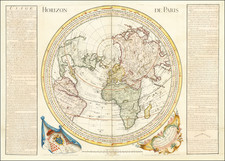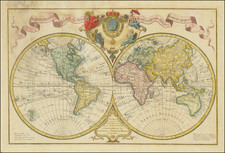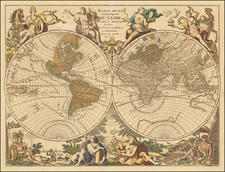Scarce Spanish map of the world by Jose Pilar Morales.
Rendered with remarkable precision, the Mapa Geológico del Globo (Geological Map of the World) is an exquisite cartographic creation that delineates the geological composition of the Earth's continents. This map, drawn by J.P. Morales and revised by J. Vilanova, represents a synthesis of 19th-century geological knowledge, presented through the innovative Homolographic projection.
This geological map is a snapshot of 19th-century scientific thought, emerging during a period characterized by rapid advancements in the geological sciences. It offers a visual summary of the various strata that compose the Earth's crust, categorized by age and type—from the ancient Precambrian rocks to the relatively recent alluvial deposits.
The vibrant color-coding signifies different geological features, providing an at-a-glance understanding of the distribution and extent of these formations across the globe. Major geological features, like mountain ranges, are indicated, offering insights into the tectonic forces that have shaped our planet.
This map not only serves as a scientific tool but also as a historical document, reflecting the intellectual currents of the era. It predates the theory of plate tectonics by several decades, yet it hints at the dynamic nature of Earth's surface, a concept that would revolutionize geology in the 20th century.
The map's aesthetics are noteworthy, with its elegant script and decorative title imbuing it with the artistic sensibilities of the time. The Homolographic projection chosen for this map is particularly significant, as it seeks to represent the Earth's surface with minimal distortion, a challenge that cartographers had grappled with for centuries.










![[World Map--The Prophet Daniel's Dream]](https://storage.googleapis.com/raremaps/img/small/82774.jpg)

![[ Scandinavian Airlines and Northwest Airlines Route Map ] make your business trip a dream trip . . .](https://storage.googleapis.com/raremaps/img/small/101758.jpg)

